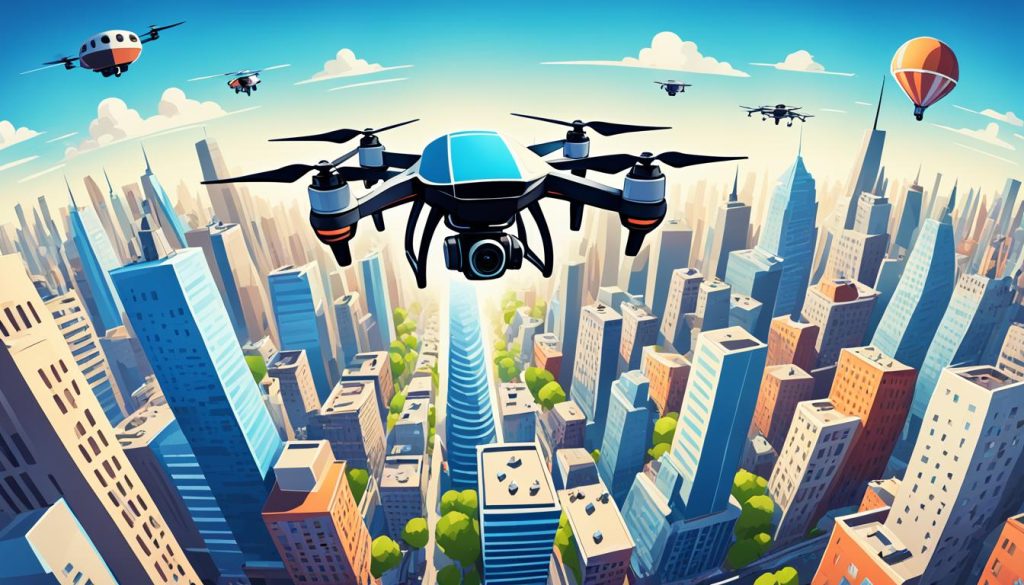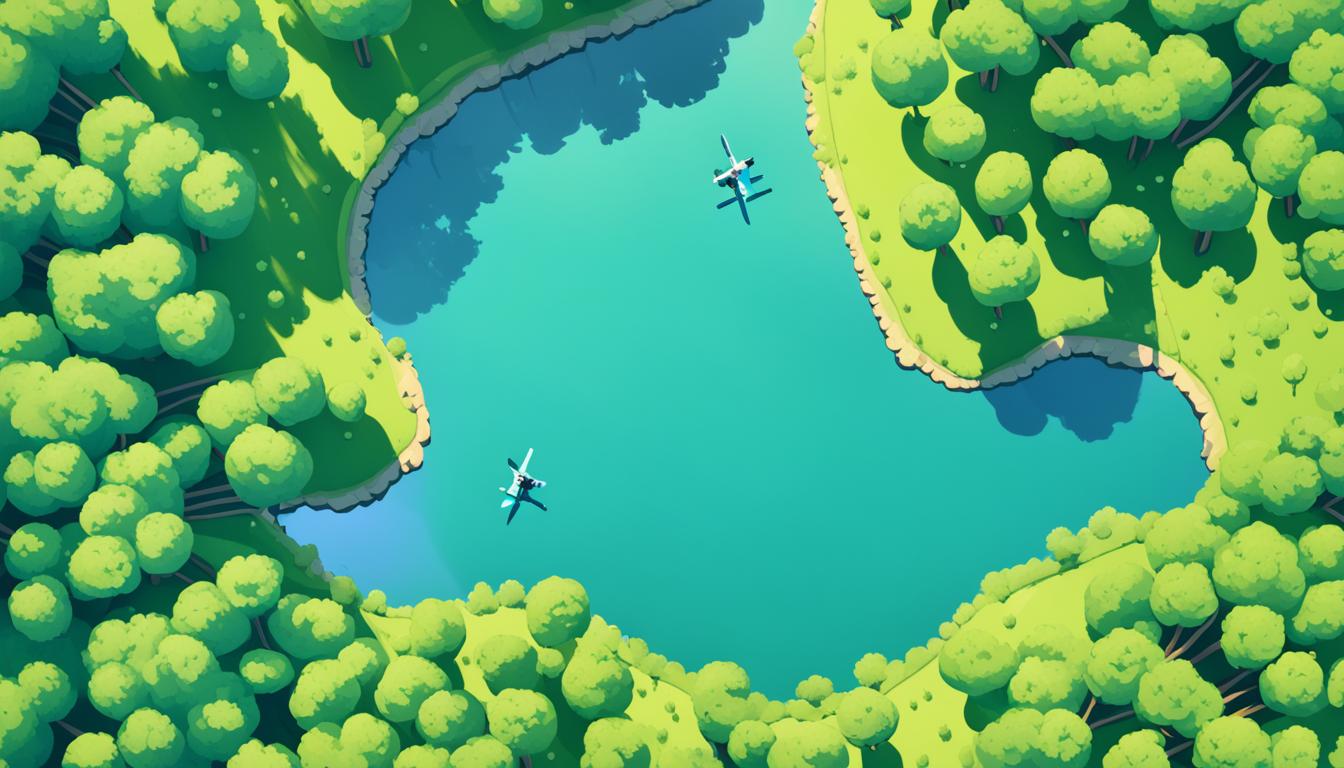Want to make your drone shots stand out? Use the Rule of Thirds for stunning vertical drone panoramas. This technique boosts your aerial photography and makes your drone images pop. Just imagine your frame split into a 3×3 grid to enhance your shots.
The Rule of Thirds is a game-changer for drone photography. It helps you place key elements on the grid lines or at their crossings. This method brings balance and interest to your shots, making them more captivating and professional.
Understanding the Rule of Thirds in Aerial Photography
The Rule of Thirds is a key idea in making drone shots look good. It helps you balance your shots and make your drone photos more creative.
Definition and Principles
The Rule of Thirds splits your frame into a 3×3 grid. Place important things along these lines or where they meet. This makes your drone shots more interesting and deep.
Importance in Drone Photography
In drone photography, the Rule of Thirds is key for great shots. It tells you to put subjects off-center for more dynamic images. This way, you avoid putting everything right in the middle.
Adapting for Vertical Panoramas
For vertical shots, tweak the rule by thinking about the tall frame. Put important things along the vertical thirds for balance. This is great for tall buildings or wide landscapes.
| Composition Element | Standard Rule of Thirds | Vertical Panorama Adaptation |
|---|---|---|
| Horizon Line | Along top or bottom horizontal third | Not always applicable, focus on vertical lines |
| Main Subject | At intersection of thirds | Along vertical third lines |
| Sky/Ground Ratio | 1:2 or 2:1 | Varies based on subject, often more sky |
| Leading Lines | Diagonal across frame | Vertical or slightly angled |
Mastering the Rule of Thirds lets you make stunning vertical drone shots. Your photos will have a strong impact and balanced look.
Essential Drone Equipment for Vertical Panoramas
To get amazing vertical panoramas, you need the right gear. You’ll need a mix of tools for aerial photography and equipment for vertical shots.
A top-notch drone with a gimbal is key for smooth shots. Make sure it has GPS for steady flights. Your drone should also have a camera that lets you adjust settings for clear panoramas.
Having extra batteries means you can fly longer and take more photos. Bring lots of memory cards to save your high-quality shots. And, remember to pack drone cases and propeller guards to protect your gear.
| Essential Equipment | Purpose |
|---|---|
| Drone with stabilized gimbal | Steady shots and smooth movement |
| High-resolution camera | Detailed image capture |
| Extra batteries | Extended flight time |
| Multiple memory cards | Ample storage for images |
| Protective gear | Equipment safety |
A good ground station app with a grid can help with your shots. It makes sure your images line up well for stitching. Also, get quality software for editing and stitching your panoramas.
With these tools, you’re set to take stunning vertical panoramas. They’ll show your world in a new light.
Preparing Your Drone for Vertical Panorama Shots
Getting ready for vertical drone panoramas takes careful planning. Let’s look at the main steps to make sure your shots look great and professional.
Adjusting Camera Settings
It’s important to fine-tune your drone camera settings for the best results. Keep your ISO low, around 100, to reduce noise. Adjust the shutter speed based on the lighting and pick the right aperture for depth of field. These settings are key for clear, high-quality images.
Configuring Drone Flight Parameters
Your drone’s flight settings are crucial for smooth panoramas. Set your altitude and speed to keep things stable. Turn on GPS mode for accurate positioning. These settings help your drone stay steady during the shoot, making stitching easier later.
Planning Your Flight Path
Planning your flight is key to success. Map out your route, thinking about overlapping shots for easy stitching. Use apps like UAV Forecast to check the weather, GPS, and no-fly zones. Practice flying in ATTI mode for areas with weak GPS signals. This careful planning and preparation leads to amazing panoramas.
- Check drone calibration
- Ensure all systems are working
- Charge batteries fully
- Pack spare batteries and memory cards
By carefully preparing your gear and flight plan, you’re ready to capture stunning vertical panoramas. These will show off your skills in aerial photography.
Techniques to Apply Rule of Thirds for Captivating Vertical Drone Panoramas
Mastering vertical panorama composition with drones opens up exciting possibilities for aerial photography. By applying the Rule of Thirds, you can create stunning images that captivate viewers. Let’s explore some effective drone photography techniques to elevate your vertical panoramas.
Start by enabling your drone’s camera grid or visualizing vertical thirds in your mind’s eye. Position key elements along these lines or at their intersections. For vertical shots, consider placing the horizon on the upper or lower third line to add drama and balance to your composition.
Experiment with different angles and heights to discover unique perspectives. Use your drone’s altitude to your advantage, capturing sweeping landscapes or urban skylines. Pay attention to the balance between sky, middle ground, and foreground elements to create depth in your vertical panoramas.
- Utilize natural lines and patterns in the landscape to guide the viewer’s eye
- Capture multiple shots at slightly different angles for more options
- Adjust your drone’s camera settings for optimal exposure in varying light conditions
Remember, the Rule of Thirds is a guideline, not a strict rule. Feel free to break it occasionally for creative effect. As you practice these techniques, you’ll develop an intuitive sense of vertical panorama composition that will set your drone photography apart.
| Element | Placement | Effect |
|---|---|---|
| Horizon | Upper third | Emphasizes foreground |
| Horizon | Lower third | Highlights sky |
| Focal point | Intersection | Creates visual interest |
By combining these Rule of Thirds application techniques with your unique vision, you’ll create vertical drone panoramas that truly stand out. Keep practicing and refining your approach to develop your signature style in aerial photography.
Composing Your Shot: Identifying Key Elements
Creating stunning vertical drone panoramas takes careful thought and focus on key elements. Let’s dive into the basics of picking the right focal points, composing your shot vertically, and balancing your drone shots. These skills will boost your aerial photography.
Selecting Focal Points for Vertical Panoramas
When picking focal points, aim for features that catch the eye. Look for architectural wonders, unique natural scenes, or interesting patterns. Place these elements in your shot to lead the viewer’s gaze and add interest.
Balancing Foreground, Middle Ground, and Background
Getting the balance right in your vertical shots is key. Think about how the foreground, middle, and background work together. Use your drone’s height to add depth. Try different heights to find the best balance that shows the landscape’s layers and improves your shot.
Utilizing Natural Lines and Patterns
Add natural lines and patterns to your shots for visual flow. Rivers, roads, or coastlines can be leading lines, guiding the viewer. Look for repeating patterns in cities or fields to add rhythm and structure. These can turn a simple scene into a stunning aerial photo.
| Composition Element | Purpose | Example |
|---|---|---|
| Focal Point | Draws viewer’s attention | Landmark building |
| Foreground | Establishes depth | Shoreline |
| Middle Ground | Connects elements | City streets |
| Background | Provides context | Mountain range |
| Leading Lines | Guides viewer’s eye | Winding river |
Executing the Perfect Vertical Panorama Capture
To get great drone panorama shots, you need skill and precision. Start by flying your drone at the right height. Use GPS mode for stability during your shots.
Start your vertical sweep, making sure each shot overlaps by about 30%. This helps stitch the photos together smoothly. Keep your speed steady and your distance from the subject the same.

- Shoot in RAW format for maximum editing flexibility
- Use manual camera settings to maintain consistent exposure
- Take multiple passes to ensure ample material
- Be mindful of changing light conditions
Always follow local drone laws and keep your drone in sight. By doing this, you’ll make stunning vertical panoramas. These will show off the beauty from above.
Post-Processing Tips for Enhancing Vertical Drone Panoramas
Post-processing is crucial for making stunning vertical drone panoramas. With the right techniques and editing skills, you can turn your photos into amazing images. Here are some key tips for enhancing your vertical images.
Stitching Multiple Images Seamlessly
Use software like Luminar Neo for smooth panorama stitching. This AI tool automatically combines photos, saving time and ensuring great results. Make sure to focus on alignment and blending to hide any seams in your final image.
Adjusting Exposure and Color Balance
For a cohesive panorama, keep your exposure and color balance consistent. The ‘Relight’ tool lets you adjust light and its source in your image. Also, the ‘Remove Dust Spots’ feature cleans up imperfections often seen in aerial shots.
Applying Final Touches to Emphasize the Rule of Thirds
Remember the Rule of Thirds when editing your drone photos. Crop or adjust your image to improve its composition. Adjust contrast, saturation, and sharpness to highlight the best in your panorama. Use selective adjustments to focus on important parts and make your image stand out.
| Editing Step | Tool/Technique | Purpose |
|---|---|---|
| Image Stitching | Luminar Neo | Combine multiple shots into one panorama |
| Exposure Adjustment | Relight Tool | Balance light across the entire image |
| Dust Removal | Remove Dust Spots | Clean up sensor dust in aerial shots |
| Composition Enhancement | Crop Tool | Adjust framing to emphasize Rule of Thirds |
| Final Enhancements | Selective Adjustments | Highlight key areas of the panorama |
Common Challenges and Solutions in Vertical Drone Panoramas
Creating stunning vertical drone panoramas has its challenges. Let’s look at some common issues and how to fix them in your drone photography.
One big challenge is keeping the exposure consistent. As you fly higher, the light changes a lot. To solve this, use manual camera settings. This helps keep the exposure the same throughout your photos. Also, shooting in RAW gives you more options when editing later.
Wind can make your drone shaky, which hurts your photos. To fight this, increase your shutter speed and use your drone’s GPS mode for better stability. These steps are important for fixing drone photo problems.

Another problem is perspective distortion, which can make your panorama look wrong. Fix this in post-processing by making sure the images line up right. Use software tools to correct any warping or distortion.
Weather can also mess up your plans. Always have a solid flight plan and backup plans ready. Being prepared is key to solving drone photography problems.
| Challenge | Solution |
|---|---|
| Inconsistent exposure | Use manual camera settings, shoot in RAW |
| Wind instability | Increase shutter speed, use GPS mode |
| Perspective distortion | Careful alignment in post-processing |
| Weather changes | Have a clear flight plan and backups |
Getting better at flying precisely is key for consistent framing in your vertical shots. Don’t give up if your first tries don’t work out. With practice, you’ll get the hang of it and make amazing aerial photos.
Conclusion
Learning to take vertical drone panoramas is a fun journey. It mixes flying skills with a creative eye. Using the Rule of Thirds can make your drone photos stand out. This method helps you make balanced shots that pull viewers into your aerial views.
The Rule of Thirds is just a guide, not a hard rule. As you find your style, try new heights, angles, and views. Your drone lets you see the world from new angles. Use it to show hidden details, beautiful landscapes, and tell stories through photos.
Good drone photography is more than flying. It’s about knowing your gear, setting up your camera right, and seeing the world in a new way. With time and effort, you’ll get better at making vertical panoramas that show us the world from a new angle.
Don’t stop exploring, learn from every flight, and keep improving. There’s no limit to what you can do with vertical drone shots and your aerial photography skills.






